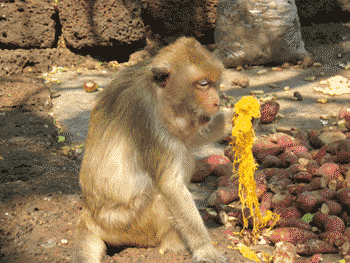Hanuman, our mighty monkey God will lead us to win our war against daleks.
http://hinduism.about.com/library/weekly/aa052801a.htm
"Hanuman: Simian Symbol of Strength!
Part 1: The Mighty Monkey!
In May, 2001, an obscure village in India's southern state of Karnataka was in news for suddenly turning into a Hindu pilgrimage — by accident! Thousands of people are still thronging to this hamlet called Theranya in Hassan district to worship a 40-feet green granite block weighing around 100 tonne that slipped off a truck while being transported to a temple in Tamil Nadu for carving out a statue of Hanuman — the monkey god. Even an unsculpted piece of rock can become a deity when it comes to the reverence shown by Hindus towards this simian icon.
Embodiment of Strength & Tenacity
Hanuman, the mighty ape that aided Lord Rama in his expedition against evil forces, is one of the most popular idols in the Hindu pantheon. Believed to be an avatar of Lord Shiva, Hanuman is worshipped as a symbol of physical strength, perseverance and devotion.
Hanuman's tale in the epic Ramayana — wherein he is assigned the responsibility to locate Rama's wife Sita abducted by Ravana, the demon king of Lanka — is known for its astounding ability to inspire and equip a reader with all the ingredients needed to face ordeals and conquer obstructions in the way of the world.
Worshipping the Monkey God
On Saturdays and Tuesdays many people keep fast in honour of Hanuman and give special offerings to him. In times of trouble, it is a common faith among Hindus to chant the name of Hanuman or sing his hymn ("Hanuman Chalisa") and proclaim "Bajrangbali Ki Jai" — "victory to thy thunderbolt strength". Once every year — on the full-moon day of Chaitra (April) at sunrise — "Hanuman Jayanti" is celebrated to commemorate the birth of Hanuman. Hanuman temples are among the most common public shrines found in India.
The Power of Devotion
The character of Hanuman teaches us of the unlimited power that lies unused within each one of us. Hanuman directed all his energies towards the worship of Lord Rama, and his undying devotion made him such that he became free from all physical fatigue. And Hanuman's only desire was to go on serving Rama. Hanuman perfectly exemplifies "Dasyabhava" devotion — one of the nine types of devotions — that bonds the master and the servant. His greatness lies in his complete merger with his Lord, which also formed the base of his genial qualities."
http://hinduism.about.com/library/weekly/aa052801a.htm
"Hanuman: Simian Symbol of Strength!
Part 1: The Mighty Monkey!
In May, 2001, an obscure village in India's southern state of Karnataka was in news for suddenly turning into a Hindu pilgrimage — by accident! Thousands of people are still thronging to this hamlet called Theranya in Hassan district to worship a 40-feet green granite block weighing around 100 tonne that slipped off a truck while being transported to a temple in Tamil Nadu for carving out a statue of Hanuman — the monkey god. Even an unsculpted piece of rock can become a deity when it comes to the reverence shown by Hindus towards this simian icon.
Embodiment of Strength & Tenacity
Hanuman, the mighty ape that aided Lord Rama in his expedition against evil forces, is one of the most popular idols in the Hindu pantheon. Believed to be an avatar of Lord Shiva, Hanuman is worshipped as a symbol of physical strength, perseverance and devotion.
Hanuman's tale in the epic Ramayana — wherein he is assigned the responsibility to locate Rama's wife Sita abducted by Ravana, the demon king of Lanka — is known for its astounding ability to inspire and equip a reader with all the ingredients needed to face ordeals and conquer obstructions in the way of the world.
Worshipping the Monkey God
On Saturdays and Tuesdays many people keep fast in honour of Hanuman and give special offerings to him. In times of trouble, it is a common faith among Hindus to chant the name of Hanuman or sing his hymn ("Hanuman Chalisa") and proclaim "Bajrangbali Ki Jai" — "victory to thy thunderbolt strength". Once every year — on the full-moon day of Chaitra (April) at sunrise — "Hanuman Jayanti" is celebrated to commemorate the birth of Hanuman. Hanuman temples are among the most common public shrines found in India.
The Power of Devotion
The character of Hanuman teaches us of the unlimited power that lies unused within each one of us. Hanuman directed all his energies towards the worship of Lord Rama, and his undying devotion made him such that he became free from all physical fatigue. And Hanuman's only desire was to go on serving Rama. Hanuman perfectly exemplifies "Dasyabhava" devotion — one of the nine types of devotions — that bonds the master and the servant. His greatness lies in his complete merger with his Lord, which also formed the base of his genial qualities."






Comment